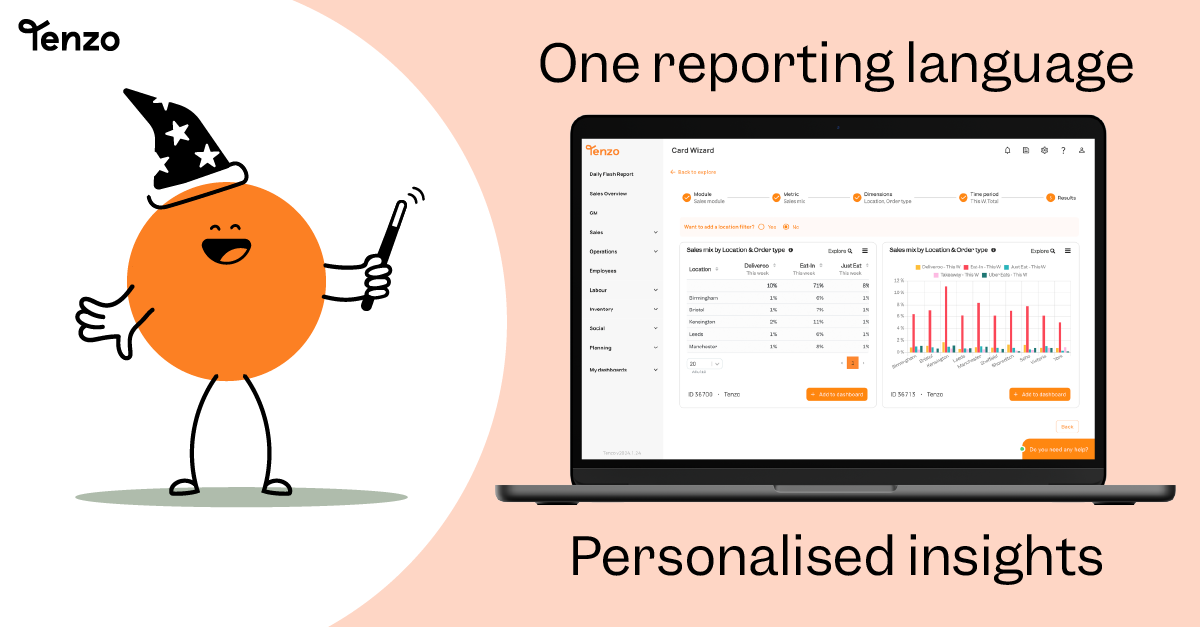It’s the ultimate question: what do my General Managers and Head Office need to see in their end-of-day report? It’s important not to overwhelm people with data, but there’s no question that having visibility over what’s happening in the business at the end of each day is key to optimising performance.
According to Scot Turner, former operator turned consultant, “understanding what happened yesterday and why the numbers looked like they did is super important to catch issues before they snowball out of control.”
At Tenzo, we’ve created thousands of dashboards and reports for customers looking for the right level of information to disseminate to stakeholders. Thanks to all this experience, we’ve seen what works and what doesn’t.
While we’ve released a template for daily reporting in Excel, the possibilities are limited. Not having a direct integration with your tech platforms leaves a lot of room for human error. But, if you use a tool like Tenzo, you can be sure to have the right KPIs on your end-of-day report in just a few clicks.
Tailoring the end-of-day report to the viewer
The important thing to remember is that these reports need to be tailored for the person viewing them. A GM just needs information on their location, an AM for their area, and HQ for the business as a whole.
If you have a multi-location group, the most frustrating thing is receiving a different email for each of the locations – not only does this create inbox chaos, it’s also impossible to see how sites compare to each other and health across the group.
Understanding what each key group or department in your business needs to see makes creating these reports much simpler and ultimately dictates if they even get used.
The core tenets of an outstanding end-of-day report
To get a full operational overview of the day there are a few key areas that need to be touched on. You need to see your revenue metrics, review your costs and understand if anything went wrong.
The way you look at these will differ by business. For example, one business might want to see sales today vs last week, while another might want to see them compared to last year. Some may want to see labour productivity numbers (sales/labour hours), and others will want to see labour cost as a percentage of sales.
Thankfully, Tenzo allows you to choose the reports that align with your business goals in a simple and easy-to-use wizard. You might even discover new insights to track along the way.
Sales report
The first metric to look at is revenue. At the very least you’ll want to see total sales today, but it’s helpful to look at trends and compare sales against a previous period: either last week, last period, or last year. This way you can benchmark current performance.
Using one restaurant reporting platform to create these reports means that everyone will be looking at the same revenue number whether you choose to include service charge or VAT in that number or not. When these reports are created in Excel, different numbers might be pulled from different systems leading to confusion and fostering a lack of trust in the data.
If you want to add another sales metric to your report, a good one to consider is sales vs budget. This shows how you performed against your financial budget to get an idea of whether you’re hitting financial targets or if action needs to be taken.
Labour report
You’ll then want to have an overview of operational costs. There are two big ones here: labour and cost of goods. On the labour side of things, you’ll want to see if your costs align with expectations.
There are two main ways of tracking labour costs: labour productivity and cost of labour as a percentage of sales. Choose whichever is best for your business. You can then track this against a cost target or include a similar comparison period to your sales metrics.
You may also want to consider the time period you’re looking at. Seeing this number week to date rather than just today helps General Managers understand how they’re performing against their targets for the week as a whole and can help them make changes if needed.
Think about getting even more granular and look at your hourly staff costs. Seeing this daily might show inefficiencies you weren’t previously aware of. According to Scot, ‘You can start looking at what time periods across the day are costing you the most and then ask questions about whether you should be open at those times, if you need that many people on shift, or if the handover period is costing you more money that needs to be spent.”
Inventory report
Your other big cost centre is the cost of goods. Cost of goods reports can be complicated to have on your daily report as it’s highly unlikely that your business is doing stock counts on a daily basis, so getting accurate usage data is nearly impossible.
However, you can get an idea of theoretical usage on a daily basis (as long as your recipes are up to date in your inventory management system). This theoretical usage can give you a broad idea of how much your COGS are as a percentage of your sales.
You can also therefore get a theoretical P&L on a daily basis by subtracting your COGS and labour costs from your daily revenue. Then, compare that number to your weekly actual vs theoretical report to understand your levels of wastage.
Special Extras
While sales, labour costs and COGS will make up the main pillars of your daily report, there are some extras that might come in handy.
Ratings and reviews
Keeping an eye on the reviews you get every day means you can nip any issues in the bud before they become real problems. Logging into review platforms regularly is just an extra task for busy General Managers but by having all that information in the daily report, GMs can make changes quickly. It also helps to see how your star rating is tracking given that a drop in star rating has a meaningful impact on revenue.
Reservations
For restaurants that have high volumes of reservations, including the number of reservations today vs no-shows or today vs tomorrow can help the team be prepared for the level of demand.
Forecasts
Similarly, if you’re using a tool like Tenzo with forecasting capabilities, seeing how you performed against the forecast as well as tomorrow’s forecast again helps the team be prepared for demand.
Closing the feedback loop in your end-of-day report
Sending operational reports is only half of the story. To get a full picture of daily operations, you also need to get feedback from the teams on the ground. This gives valuable context to the numbers shown in reports.
Most businesses we’ve come across have used Whatsapp or an Excel template to do this. The problem here is that this feedback then lives separately from the quantitative data and comparing the two becomes a nightmare of trawling through old texts or emails to find any trends.
Using a reporting tool that allows GMs or shift managers to give valuable input on how the day is gone and keeping it in the same platform as your key metrics means that you can see it all in one place. Either by seeing it in the same dashboard or as part of your daily email.
You can complete the loop of giving operational reports and receiving feedback all in one place.
Final Reflections
The best end-of-day report is the one that’s tailored to your business with your goals in mind. Using a tool with the flexibility to create those reports without spending hours in Excel and that automates the information you need will mean that the data surfaced will actually be engaged with.
There will be periods of experimentation while you decide what works for you and what doesn’t. According to Tenzo founder and former restaurateur, Christian Mouysset, ‘How do you keep this simple enough not to overload people?
It’s getting that balance right of being able to look at a quick graph to get a sense of whether things are looking good or need adjusting and actually looking at the numbers and understanding more precisely what’s happening. Getting that balance right gets the best engagement from your team.’
Getting the right balance requires trial and error and with Tenzo’s new card wizard, you can explore the metrics you want to try, edit dashboards and create the best daily emails for your business without the pain of building new spreadsheets every time.
Get in touch today to see how Tenzo can help you create the best possible end-of-day report for your business.





